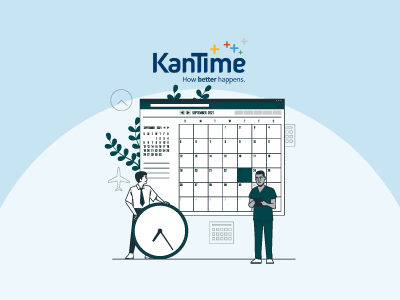Research shows that scheduling inefficiencies are a significant contributor to staff turnover in home health agencies, with the average caregiver turnover rate reaching 79.2% in 2024. This challenge highlights the need to implement a reliable system like KanTime home health and hospice software to streamline visit scheduling, reduce last-minute changes, and manage your agency’s overtime goals.
Here, we will walk you through the step-by-step process of scheduling visits in KanTime to ensure you assign the right clinician to the right patient and keep your agency running smoothly.
- Open the ‘Scheduling’ tab to view unassigned shifts
- Select a day to see available slots that need to be filled
- Once you have opened the scheduling tab, access the configurable attribute matching tools to match patients with the most suitable clinician
- Use the ‘Search Criteria’ box to define patient needs and clinician qualifications
- Select attributes such as ‘Required Skills,’ ‘Patient and Clinician Preferences,’ and ‘Assigned Region or Team’
- Configure ‘Control of Clinician Overtime’ to manage workload distribution
- Use the ‘Clinician Search Wizard’ to filter clinicians based on additional requirements like Wound Vac or IV certification
- Compare available clinicians based on availability, skillset, and proximity to the patient
- Assign the clinician based on the patient’s needs
- Click on the ‘Split Shift’ tool to automatically divide shift hours based on the defined split time
- Document the shift on a single note and choose to split by ‘Payer’ or ‘Service’ either upfront or after the visit
- Review the schedule to ensure accurate timekeeping and billing
- View multi-discipline client calendars simultaneously
- Send calendars to your clients via email or the family portal
- Access the ‘Dashboard’ to view alerts on schedules requiring immediate attention
- Check ‘Open Schedules’ to identify patient visits that don’t have an assigned clinician
- Review ‘Unconfirmed Schedules’ to follow up on visits clinicians haven’t acknowledged yet
- Monitor ‘Pending Check-Ins’ to track visits where clinicians haven’t checked in on time
- Resolve ‘Double Bookings’ to prevent conflicts where a clinician is scheduled for two visits at the same time
- Use ‘Drag and Drop Modifications’ to move visits between available time slots seamlessly
- Receive real-time alerts if a modification creates a conflict, such as a double booking or a payor rule violation
- Prevent scheduling conflicts by adjusting visits within the Medicare week or other payor-defined periods
- Enable ‘Repeat Scheduling’ to auto-generate recurring visits based on the period of care or authorization (e.g., weekly, biweekly, or every three weeks)
- Configure alerts to notify users when a schedule change exceeds allowed work hours
- Use the ‘Ad Hoc Visit Tracking’ tool to let caregivers clock in and out for unscheduled visits
- Document completed tasks and validate authorization parameters to ensure compliance
- Communicate unscheduled visits to the office for payroll and billing review
Efficient scheduling can significantly impact your agency’s capacity to deliver quality care and operate smoothly. KanTime has helped agencies schedule over 211 million visits, which demonstrates its ability to effectively prevent double bookings, reduce open schedules, and eliminate the need for manual shift entries. You can also follow the steps outlined above to make the most of its powerful scheduling tools.
If you’re still unsure how to navigate the system or want to explore more features, check out our comprehensive guide on how to use KanTime to streamline your agency’s workflow.
